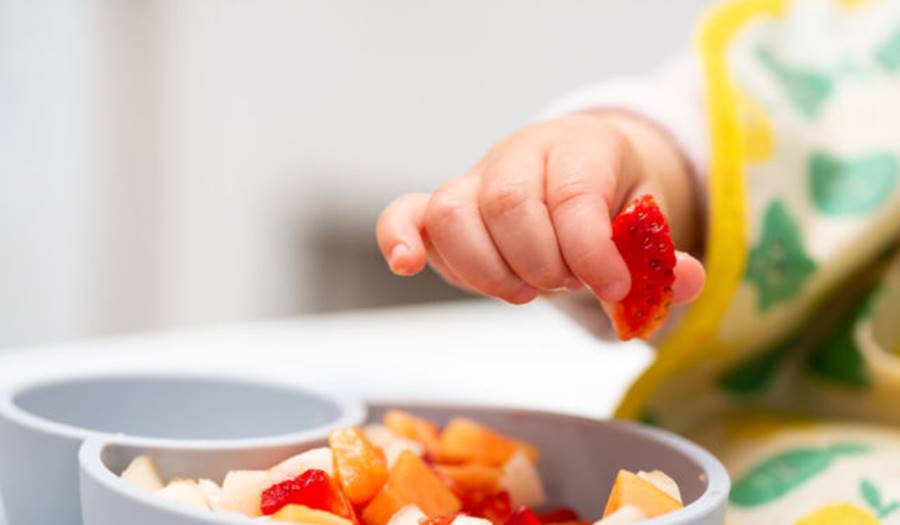
Starting Solids
1/18/2021
Food is a necessity for life. We are born needing to eat immediately and that need continues throughout our life. Food doesn’t just provide nutrients and energy. It also provides enjoyment and is a social activity.
But how do we start babies on food complementary to breast milk or formula? There are different recommendations and advice. And the people offering the advice can feel very strongly about their recommendation. You will hear start right at 4 months and don’t start until 6 months, only offer this texture, never give this texture. These groups are misguided. There is NO exact right time to start solids that is set by a deadline. It is 100% dependent on YOUR baby. Like other developmental milestones, there is a range in which babies are ready to start feeding. YOUR baby will be the best person to determine when it is right to start solids. In this post we will learn all about how and when to start solids.

STARTING SOLIDS
PRE-FEEDING PREPARATION
Preparing your baby to eat solids actually starts at birth! Babies need to progress through certain gross motor, fine motor and oral motor skills before they are ready to try solid foods.
Tummy Time
Tummy time is important for gross motor development. It helps prepare core and arm muscles for rolling, sitting, and crawling. It also is important in the development of mouth and neck muscles that are essential for oral motor skill development. Your child should be getting 10 minutes of tummy time a day before 6 weeks of age and 3-5 sessions of 3-10 minutes of tummy time daily after 6 weeks of age.
Tummy time can be on the floor, on your chest, or in carrier while they are awake and able to move their head to look up. Not all babies love tummy time. If your baby doesn’t like tummy time, don’t be afraid to help position them so they are more comfortable. Some babies like a rolled towel or nursing pillow placed under their chest while some babies need some extra hip support with a folded washcloth. Some babies do better in a more upright position such as being positioned (while well supervised) on a couch arm. Also providing a mirror, a toy, or a favorite person to look at can help prolong the time they tolerate in this position. Your baby should always be supervised while doing tummy time.
Oral Sensory Experiences
Prepare your baby for having food in their mouth by letting them put things in their mouth! Babies like to explore using their mouth and this exploration increases between 3-5 months. “Mouth play” helps them learn how bring things to their mouth. It lets them practice closing their lips around an object, biting, and moving items further back into their mouth. Mouth play is also important for teaching tongue movements that are essential to eating. The most important being the lateral tongue reflex. This reflex helps move food right and left during chewing. It can take 2 years to be fully perfected. Teething toys placed in the middle of their tongue actually stimulate the tongue to move the teether side to side and is a great exercise to practice the movement without needing food.
Babies also get used to different textures in their mouth during this time, so it is important to vary the texture of their toys. Textures should include smooth, rough, ridged, and chewy. Mouth play also helps them (and you) get used to gagging and decreases an oversensitive gag reflex.

ASSESSING FOR READINESS
Determining the right time to start feeds requires you to assess your family and your child for readiness. First, we need to assess the best starting time for your baby and your family. The American Academy of Pediatrics recommends delaying the introduction of complementary food (solids) until a baby is 6 months old if they are exclusively breastfed (meaning they drink only breast milk either from the breast or bottle). Breast milk as their SOLE food helps promote good gut health and may reduce allergic reactions to foods. If you are exclusively breastfeeding and would like to delay until 6 months based on the AAP recommendation that should be part of your readiness assessment. This recommendation may not be appropriate for your child or family and you may choose to start solids before 6 months. Please talk with your primary care provider about the right decision for your child.
Next, you need to assess your baby’s developmental readiness. Babies reach feeding milestones at different times just like every other milestone! The first step is assessing YOUR baby to see if they have all the signs of readiness.
Feeding skills happen in a certain progression much like gross motor skills. We know the most common progression of growth motor is sitting, crawling next, then cruising, then walking. Oral motor skills are similar. Your baby starts practicing oral motor skills in utero by swallowing amniotic fluid. Once born they use that skill to swallow breast milk or formula using a forward and backward tongue motion. Around 6 months babies start shifting to a mature swallowing pattern, but this takes up to 12 months of practicing with purees and soft solids. They also start working on chewing skills which develop until age 2 and then get refined or fined tune up to age 3!
In order to be ready to work on these oral motor skills, we need babies to show these signs of readiness:
• They can hold their head up with good control
• They show interest in your food
• They drool (they need saliva to start the digestive process)
• They lean forward and open their mouth when food is presented
• They can move food off of a spoon (close their lip around a spoon and pull back to get solids off the spoon)
• Ideally, they should have good trunk control and be able to sit well in a supported position
Please note that your babies DOES NOT need to be rid of their tongue thrust reflex to start solids. This reflex can take until 6-9 months to disappear and in some children up to 12 months. Please note that some babies that continue taking a bottle or pacifier AFTER 12 months will continue to have a tongue thrust reflex. This can hinder normal oral motor skill progression so weaning at 12 months is highly recommended.
HOW DO I START FEEDS?
If you have done research into starting solids, you will once again find polarizing recommendations. There are really 2 “camps” in methodology. One is starting babies on a progression of purees. The other popular plan that you may encounter in your research is Baby Led Weaning (BLW) in which babies over 6 months who are proficient sitters are offered soft solids and are allowed to self-feed.
Guess what? The good news is you should and can incorporate the best part of both these plans! Babies need both purees and access to soft solids when learning to eat since both of these textures and foods are part of an adult diet.
Your child’s development will help guide what type of food you start feeding them. Babies and families will determine different times in which they will be starting solids, the way you start solids SHOULD AND WILL differ. Remember there is right way to do solids is the choice that is right for your family and especially your baby.
SET UP
It is important to make sure you are prepared for feeds before starting. This means making sure you have the right equipment for feeding. Here is a list of recommended items. Specific recommendations can be found here.
Highchair or Seating
Most importantly is a supportive seat for feeding. We want the highchair to support your baby’s trunk to help with feeding skills. A seat that is not supportive makes it harder to eat and can interfere with feeding skills.
A properly fitting highchair will have a foot support (this can be added after if your chair does not have this). Your child will need something to push their feet against once their knees bend at a 90-degree angle. Before that point, the calf-support the seat provides should be sufficient.
If your child needs more trunk support, you may need to modify your chair with rolled towels or inserts. We want their trunk and hips to be stable. We also need the tray to be at the right height. The tray should not be above the nipple line. If it is, it will interfere with their ability to use their arms/elbows for stability. They will not be able to make an effective pincher grasp for self-feeding.
Utensils
In a previous blog post about picky eating, we discussed proper utensils for infants. Proper sized utensils are extremely important for learning to feed. We want spoons that feature a short flat bowl, a short fat handle, and possibly a lip guard such as the “Grabease” baby spoon. This type of spoon helps babies control the amount of food in their mouth. The short wide handle is easier to hold and manipulate. And the lip guard helps keep the spoon in the proper spot in their mouth. Other spoons, such as “Gootensils”, are short, flat and have a ridged texture. These can start off as teething toys and then can be pre-loaded with a puree. This is a great self-feeding spoon since the ridges hold the food onto the spoon.
Another feeding accessory that can be useful in early feeds are silicone feeders. These are long silicone pouches with wide holes that babies can hold. They are not to be used for every feed, but they can help develop chewing skills. They are also great for teething. You can fill the feeder with frozen fruit, a frozen breastmilk or formula “popsicle”, and other hard foods. They are a great way for a baby to experience different tastes and foods that may otherwise be a choking hazard.
Hunger
Before trying solids, especially when it is a brand-new skill, try to make sure your baby isn’t hungry! This sounds counterintuitive but if your baby is very hungry, they will not be able to fully engage in learning a new skill. Some people choose to provider a portion of the feed before solids and the rest after. Some families choose to feed solids 1 to 1.5 hours after a full feed. You will need to see what works best for your baby and schedule. And remember, before 9 months food is in ADDITION to breast milk or formula never instead of breast milk or formula.

SPOON FEEDING
Spoon feeding is probably the most familiar way to start a baby on solid foods. When starting purees make sure you are set up to start feedings. You want to make sure your child is
If you will be starting solids closer to 4 months or your baby is just starting with good head control, you should start with a very thin texture. The texture of the puree should be similar to breast milk or formula. And older baby who is sitting on their own may be able to handle a thicker puree or a very soft solid that has been mashed such as cooked carrots.
The first time you give a baby a puree you may want to actually add a small amount of breast milk or formula to the puree to add a familiar flavor. You can start with an infant cereal or you can start with a fruit or a vegetable. Many people will tell you not to do a sweet fruit first or they will not like vegetables. Research does not support this to be true. It is also WAY too late for that. Breast milk and formula are high in carbohydrates which is essential for growth. Babies have already been introduced and predisposed to like very sweet tasting food. The most important factor for acceptance of veggies is consistently and frequently offering them to your child.
When you offer your baby a spoon feed you want them to lean forward toward the spoon and open their mouth. If they are resistant, you can try using your finger. If they still are not interested, hold off and try again another time.
If they are interested, load a SMALL amount of food onto the spoon. Offer the spoon to them by keeping it flat and still. They should close their lips around the spoon and pull the food off. DO NOT scrape the food off onto the roof of their mouth. This makes the tongue thrust forward and prevents babies from developing a mature swallowing pattern. Let them fully swallow before offering another bite. This is not a race! It should be an enjoyable learning experience!
You can also preload the spoon with food and hand it to a baby who is ready to self-feed. Often, they will want to keep the spoon so sometimes using 2-3 spoons in a rotation can be helpful
BABY LED WEANING (BLW)
BLW is a feeding plan where soft solids are presented to babies who self-feed these solids to themselves. This method helps support hand and eye coordination. It also helps promote chewing skills and hand dexterity. Babies are allowed to explore taste and texture on their own terms.
BLW does not and should not mean that babies are not give purees. Purees are not a single texture but have variations from thin to thick. Purees important in developing the proper timing of swallowing as well as the development of tongue muscles. Purees also provide experiences with new textures, tastes and temperatures. Purees can be spread on their tray so they can use their fingers. They can also be pre-loaded on to a spoon that they can then use to self-feed.
Also remember, that BLW doesn’t mean that a parent can’t help with feeding. You can participate by loading a spoon. You can also help hold and steady a larger piece of food which helps provide stability while a child is learning to manipulate a food to their mouth.
WHEN DO I START FINGER FOODS?
FINGER FOODS
Finger foods can be started on a baby who can sit up, bring objects to their mouth, and has an emerging pincer grasp. Grasping and brining object to the mouth often starts around 6 months with a raking type grasp. Babies who are 7-8 months old are working on a thumb finger grasp that by 12 months will be a perfect pincher grasp.
It is very important to start transitioning your child to soft solids or finger foods. Purees are a great and safe start to eating solid food, but they offer NO practice for chewing or mature swallowing skills. If children linger too long on purees, they are at risk for feeding issues because they are unable to practice necessary skills for feeding development.
We often see prolonged puree feedings today due to pouches! Pouches are convenient but should only be used occasionally unless you are medically directed to do so. Pouches are
• high in sugar
• promote tooth decay,
• can actually create pickier eaters due to the high sugar content in their food and lack of texture
• hinder oral motor skills!
Save pouches for emergency snacks and make sure your child is getting whole food for all meals and snacks once they progress to finger foods.
Finger foods should be soft enough that you are able to mash it with a fork. These can be mashed or as your child is able to pick up smaller pieces, finger foods can be diced into pieces or cut into long strips. Offering your child what your family is eating can be a great way to encourage your child to try new finger foods! Just limit any “hot” spices or extra salt. It is also ok to offer your child small sips of water during their meal when they are starting finger foods.
It is also important to note that with finger foods, stools with noticeably change in color, consistency and odor due to the food and fiber!
WHAT ELSE DO I NEED TO KNOW?
WHAT DO I FEED MY BABY?
Before 6 months, we want babies to eat fruits, vegetables. You can also add in infant cereal which can help provide an iron source to your baby. Once you baby progresses to soft food or finger food, we want babies to be exposed to soft foods that can be mashed, diced, or cut into strips. We want to avoid choking hazards Some foods that are choking hazards can be offered in forms that are easier for babies to mash with their gums. For example, ground meat instead of a piece of steak, or a nut butter instead of a hard nut. And we always avoid honey until after age 1 due to the risk of botulism infection.
We want children to be offered a varied diet that includes fruits, veggies, beans, grains, eggs, fish, and meat. Babies can also have small amounts of dairy such as yogurt, cheese, and butter but should NOT be given whole milk instead of breast milk or formula Babies are adventurous eaters! Don’t be afraid to offer things that may not be seen as traditional “kid” foods. Don’t’ be afraid to let them try everything! And if they don’t like it, try again! Keep introducing foods they may not accept immediately. It can take over 20 tries or exposures of something before a child will consistently eat a certain food.
If your family is vegan, vegetarian, or has any dietary restrictions, please discuss this with your provider so we can make sure they are getting adequate nutrients such as calcium, folate, and iron, from other food sources.
Your child will generally start with one feed a day. The food should be in addition to breast milk or formula. You can increase their feeds to 3 feeds a day by 9 months. Then between, 9-12 months they will start having 3 meals and possibly 2 snacks a day. As their food portion increases during this time their breast milk or formula intake may naturally decrease. This is normal They should still nurse at least 3 times a day and take at least 16-20 ounces of formula.
WHAT IF MY BABY REFUSES PUREES?
What if your baby refuses purees? Try the food in different forms and served in different ways. If they won’t take food off a spoon, try letting them self-feed off the spoon. Or try spreading the puree on the tray and letting them feed themselves the food off their own fingers. You could try dipping a teething toy in the puree or try a fork mashed version of the food to see if they are ready to advance to a more advance texture. Your baby may be ready for that texture before you are! Just like you may not be ready for them to walk but they are going to go ahead a do it! A child who is ready to progress to new textures may refuse a texture that is no longer developmentally appropriate for them.
Allowing a new feeder to finger feed a puree can be advisable for kids who are sensitive to new situations. Babies have very sensitive mouths. Finger feeding allows a baby to get feedback through their skin, muscles, and joints and it prepares their mouth for the food they are about to take.
ALLERGENS
If your baby has no risk factors, you can start introducing highly allergenic food any time after 4-6 months but after you have introduced at least a few other low allergenic foods. Highly allergenic foods include peanuts, tree nuts, and eggs. Peanuts or tree nuts can be introduced as nut butters. These can be heated and stirred into oatmeal or a fruit or spread on toast. They should be thinned or spread thinly because they can be a choking hazard if they are too thick.
If your child has mild to moderate eczema or any risk factors, allergens should be introduced around 6 months. If your child has risk factors including severe eczema, strong family history of a parent or a sibling having a food allergy, or a previous allergic reaction particularly to eggs, it is recommended you discuss starting allergenic foods with your provider. Depending on their case they may recommend an allergist consult before starting these foods.

GAGGING AND CHOKING
Gagging
Gagging is a normal reflex that helps prevent food from entering the airway. It is very common for new feeders to gag when learning to feed just like it is common for a baby to wobble and fall over when learning to sit! Before 6 months of age, the gag reflex is present on the front part of the tongue. Between 6-9 months it can be found moving towards the back of the month, where it normally settles after 9 months.
When gagging a baby may looked surprise. They may cough and make sounds. They also may turn pink or red. A gagging episode should resolve quickly. As hard as it is, your goal during gagging is to stay calm, don’t touch your child as it may startle them INTO choking. You can offer a small sip of water but do not force food or drink into your child.
Choking
Choking is when food is blocking the airway stopping air from entering. During a choking episode your child may look panicked, may turn blue and will make little to no sound. This needs immediately attention. If you haven’t taken an Infant CPR class, please look into resources as soon as you can to learn the Heimlich maneuver as there is a version specific to infants and children.
To prevent choking make sure you do not serve them food that is hard and needs molars to shred or mash. Also cut any circular food until at least age 4. Circular foods include grapes, cherry tomatoes, blueberries, and hot dogs.
CLEAN UP
Babies are messy eaters! But it is very important to not frequently clean them up during feeds. Babies explore food while eating and frequent cleaning can disrupt this process. Part of learning is making the mess. How they are feeding is just as important as what they are eating. In addition, it can be very disruptive. Faces and mouths are particularly sensitive. Frequent scraping of their mouth or wiping of their face is disruptive to the nervous system and eating process. It can lead to food aversions or negative associations with feeding.
We realize food on the face can result in rashes. If your child gets a rash from food on their face (not hives or an allergic rash), you can apply an ointment such as Aquaphor or coconut oil to their face BEFORE a feed to protect their sensitive skin from irritation. Also, if your child hates being cleaned up, once your child is done eating, you can remove them from their highchair and clean them in the bathtub, near the sink, or in a different location to limit the association with feeding.
Starting feeds with your baby can be exciting and scary. If you have an concerns about your child’s feeding skills, progressing through food stages, or their nutrition, please do not hesitate to discuss this with your primary care provider.
Children’s Health Care of Newburyport, Massachusetts and Haverhill is a pediatric healthcare practice providing care for families across the North Shore, Merrimack Valley, southern New Hampshire, and the Seacoast regions. The Children’s Health Care team includes pediatricians and pediatric nurse practitioners who provide comprehensive pediatric health care for children, including newborns, toddlers, school aged children, adolescents, and young adults. Our child-centered and family-focused approach covers preventative and urgent care, immunizations, and specialist referrals. Our services include an on-site pediatric nutritionist, special needs care coordinator, and social workers. We also have walk-in appointments available at all of our locations for acute sick visits. Please visit chcmass.com where you will find information about our pediatric doctors, nurse practitioners, as well as our hours and services.
Disclaimer: this health information is for educational purposes only. You, the reader, assume full responsibility for how you choose to use it.








